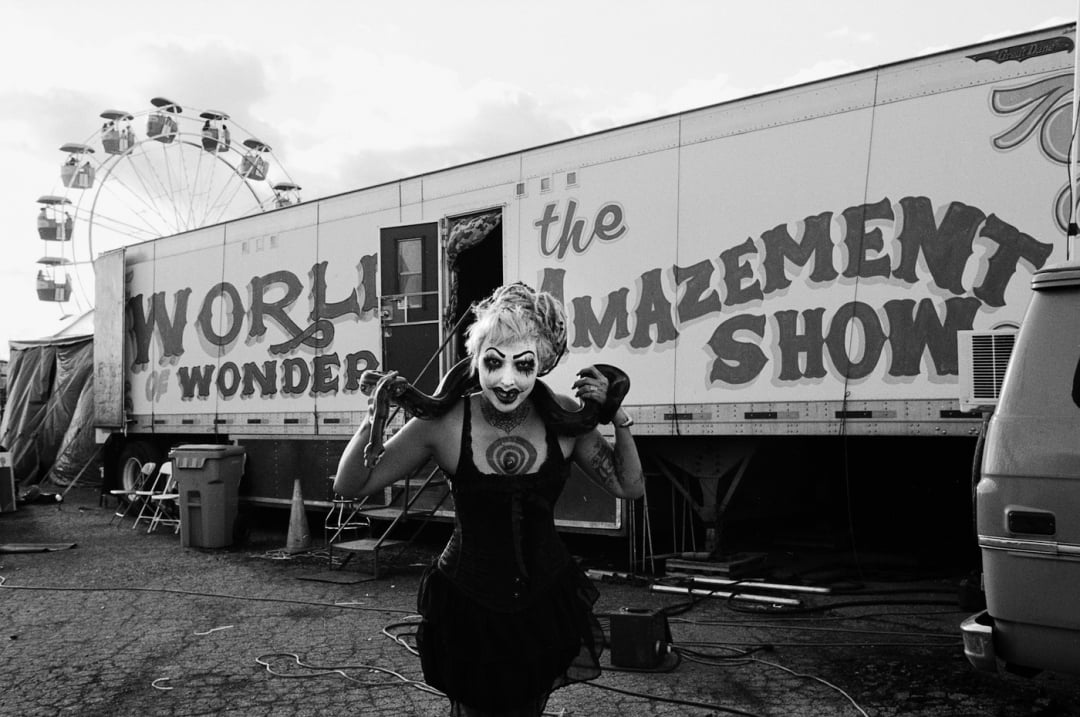Hyperallergic
Portraits from One of the Last Traveling Sideshows in the United States
He later visited Gibsonton, Florida, where carnival performers and workers live off-season, and it’s not unusual to see a ride or exotic animal in a front yard. While in town, he reached out to a man named Ward Hall who had founded one of the last surviving traveling sideshows. “I stopped at a gas station and looked him up in the phone book, called him, and went to his house the next day,” Barnes said. There he spent hours transfixed by Hall’s stories of life on the road, and the photographs and ephemera of the vanishing sideshow.
Barnes soon went on the road with Hall’s sideshow — the World of Wonders Show — joining its stops at fairs in Maine. His black-and-white portraits of the carnival’s community appear in Tickets, published by Reel Art Press. Selections from the series are currently on view in an exhibition at Milk Gallery in Chelsea. The carnival is a fading industry, eclipsed by amusement parks and elaborately produced circuses, struggling against maintenance costs and sparse booking schedules. Yet there remains a closely knit world of people who adhere to its nomadic lifestyle.
People and subcultures on the margins in the United States are frequently the focus of Barnes’s photography, whether low rider car clubs of New Mexico, or the Nez Perce people guarding traditions on the reservations. Tickets follows his 2015 Roadbook, which records the travelers he’s met while exploring the country, and the 2012 Testimony of Serpent Handling, on the serpent handler churches of West Virginia. Like those previous books, spending time with the sideshow workers for Tickets was an important part of his approach, especially as his subjects tend to be overlooked or stereotyped by the wider public.
“Before I even start taking pictures, I’m just hanging out with people,” Barnes said. “That first week, I didn’t even take pictures. I have to get to know who they are to show the true side of who someone is. Sometimes I think that’s like 90% of the process.”
And it’s what gives his photographs such pathos, when they could revel in strangeness or spectacle, particularly with a surreal setting like the carnival. There are sword swallowers, tattooed ladies, jugglers, fire eaters, tiger tamers, and straitjacket escape artists, but the humanity of the performers is at center. Flipping through the photographs in Tickets, it’s often not clear who is the spectator, and who is the performer. Each person here is attracted to a throwback style of entertainment, and there’s a sense of defiance in that. Indeed, although there are signs that these images are contemporary, such as a New England Patriots hat or a The Crow t-shirt, they could easily be mixed in with Edward J. Kelty’s 1930s circus photographs, or Jill Freedman’s more gritty 1970s Circus Days, a quality reinforced by Barnes’s use of black and white film and a 1960s camera.
“I feel like shooting film, there’s a different soul to it,” Barnes explained. “I also feel like it’s a process where it allows you to develop these relationships. The way that I travel and get to know everybody, it’s not a fast process and neither is shooting film, it goes hand in hand.”






